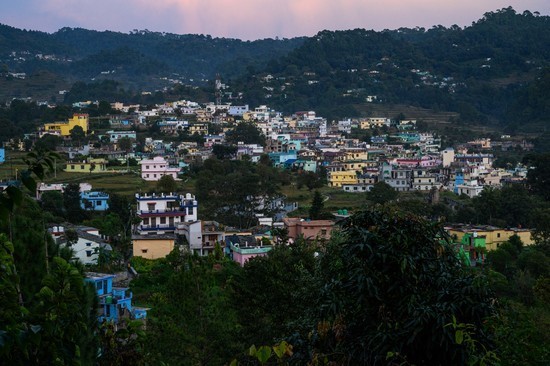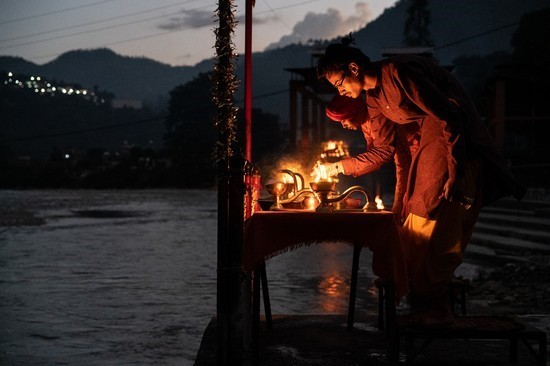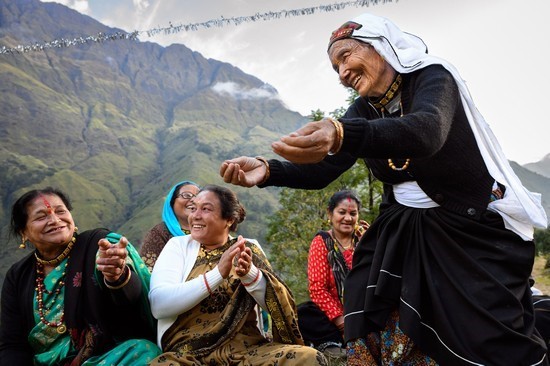In a high hamlet, a two-hour trek
up a verdant slope beneath ice-clad Himalayan peaks, an argument erupted over a
folk tale. Two brothers, Pralad Singh Dariyal, 60, and Hira Singh Dariyal, 77,
heatedly debated which nearby village in the Johar Valley was once the home of
the story’s heroine. Eventually agreeing on a few possible locations, Hira said
that the story, which is sung as a ballad and which he remembered from
childhood, was virtually unknown today among the area’s young people. “They’re
the YouTube generation,” he explained with a shrug.
اضافة اعلان
“No one even knows how to sing it anymore,”
Pralad added.
 The town of Dwarahat,
India, where Katyuri-era carved-stone temple complexes are tucked among its
brightly colored houses and gardens.
The town of Dwarahat,
India, where Katyuri-era carved-stone temple complexes are tucked among its
brightly colored houses and gardens.
The voice of Pralad’s wife, Sundari Devi,
rang out from the kitchen into the courtyard, where I sat with the brothers and
a couple of other people in front of clothing drying on a line and pieces of a
butchered sheep drying on a neighbor’s stone-shingled roof. “You don’t know
what you’re talking about,” she shouted. “Some people do remember how to sing
it. Just because it’s old doesn’t mean it’s not important.”
In the Kumaon region of the Indian state of
Uttarakhand, where sky-scraping summits soar over a maze of sublime hills in a
corner of the country that abuts Nepal and Tibet, the story known as “Rajula
Malushahi” has been passed down orally for hundreds of years. A sprawling epic
of adventure and true love that unfurls across a broad swath of the landscape,
it has long been recognized as Kumaon’s preeminent folk tale. Short versions
were sung by parents to their children, while renditions lasting up to 10 hours
were performed by hurkiyas, or traditional bards, who chanted and drummed
alongside a handful of backup vocalists for local audiences, often as a way to
pass cold winter nights, before televisions — and now smartphones — became
ubiquitous.
It seemed fitting that planning a trip around a centuries-old folk tale was more an act of creative interpretation than a strict adherence to a single text.
When I first learned about “Rajula Malushahi”
on a previous visit to Kumaon, I was immediately intrigued. After reading as
much of the literature about it as I could find, I decided on a recent trip to
use it as a guide to traveling through the area, letting it take me places I
might not otherwise think to go.
While creating an itinerary, I realized
that there was no definitive route to follow, since there is no definitive
narrative. Before it was first written down in the 1930s, numerous versions
were sung. Although they tend to share the same overarching plotline, there are
many variations among them, including where certain episodes are said to have
occurred. It seemed fitting that planning a trip around a centuries-old folk
tale was more an act of creative interpretation than a strict adherence to a
single text.
The trader’s daughterI headed first for the Johar Valley, which
is where the story (according to most versions) begins. There, a girl named
Rajula, who was so beautiful that the sun paled before her, was born into the
Shauka tribe — one of the subgroups of shepherds generally known as Bhotias.
Her father, Sunapati Shauk, was the richest trader in the region, shuttling
goods over the Himalayas between India and Tibet on the backs of sheep and
goats, the best animals for navigating the treacherous terrain. Historically,
this once-lucrative route thrived for about 1,000 years before collapsing in
1962 with the outbreak of a war between India and China and the closure of the
border.
In the story, Rajula grows into a clever
and confident young woman. She meets Malushahi, the young monarch of the
Katyuri Kingdom, which ruled Kumaon from around the seventh to the 11th
centuries, and they fall in love. They are quickly separated, however, as her
hand has already been promised by Sunapati to the son of a Tibetan king, an
important trading partner. Rajula, rebelling, escapes from this undesirable
arrangement, then travels through Kumaon to find Malushahi again, overcoming
numerous obstacles with her courage and quick wits. After many dramatic twists,
including deceptions, murder, and sorcery, the lovers are finally reunited —
either happily or in death, depending on the version.
After initially arriving in Delhi at the
end of September, I traveled for a few days — first by rail, and then by road —
to the Johar Valley’s main town, Munsiyari. My friend, writer Shikha Tripathi,
who is herself Kumaoni, happened to be there working on a story about climate
change. Together, by SUV and on foot, we traveled for most of a morning to the
village of Paton, where we talked in the courtyard with the Dariyal brothers,
as Shikha translated.
A feast and a songOur conversation concluded when a
village-wide feast began. A woman who had married a man with family in Paton
was making her first visit — 13 years after their wedding. Everyone came out to
welcome her, including people who now lived elsewhere and had returned for the
celebration. Vats of rice, mutton, and dal had been prepared, and we ate on
flat rooftops with views of the valley walls slanting sharply into the clouds.
They sang for about five minutes, which was more than long enough to transform the dimly lit room into a musical time machine, transporting us beyond the temporal world into the wonder of the moment.
When the feast wrapped up, Shikha and I
went back to Pralad’s place to get our bags and shift to the house where we had
been offered accommodations for the night. I stepped into the kitchen to bid
Sundari goodbye and found three other women sitting on the floor with her.
Before I could say “thank you”, two of them began to sing, filling the
low-ceilinged space with the resonant tones of the first verses of “Rajula
Malushahi”.
They sang for about five minutes, which was
more than long enough to transform the dimly lit room into a musical time
machine, transporting us beyond the temporal world into the wonder of the
moment. It was Sundari’s gift to us — and was her way of conclusively proving
the point she had made to her husband.
Festival drumsThe next day, Shikha and I hiked, drove and
hiked (uphill again) to a village where Hira had told us that some of Rajula’s
community had scattered after being cursed at the end of her story. Upon
reaching Jimia, we learned that a celebration of the Hindu festival Dussehra
was about to begin.
 The Hindu ritual of arti is performed near
the confluence of the Saryu and Gomati Rivers, in Bageshwar, India.
The Hindu ritual of arti is performed near
the confluence of the Saryu and Gomati Rivers, in Bageshwar, India.
Led by drummers and men carrying saplings
adorned with flags and tufts of yak hair, a joyous procession descended from the
homes at the core of the village to a small temple at its edge. Two sheep were
sacrificed to the local goddess, Bharari Devi, a form of Durga, a major Hindu
deity. The drumming surged with fevered intensity and the jagar — a ceremony in
which the goddess enters into the body, or bodies, of one or more of those in
attendance — began around a smoldering bonfire.
A possessed woman staggered around like a
zombie. A man named Gajendra Singh Quiriyal — the village’s grand pradhan, or
leader — fell to the ground and convulsed on the fire’s edge, caking himself
with ashes and embers. The goddess then settled into Rudra Singh Quiriyal,
Gajendra’s brother. Blankly staring at something no one else could see, he
flung rice over himself and into the crowd. Villagers shouted questions one
atop the other, like a scrum of reporters at a chaotic news conference, seeking
help with their problems. Most persistent was a middle-aged man desperate for
his wife to have their first child. Bharari Devi promised to grant his wish.
When the jagar was over, the pradhan, who
had brushed himself off, asked me to snap a picture of him with his wife and
daughters and insisted that Shikha and I stay with them that night. Rice and
meat from the sacrificed sheep was served to all. On a grassy terrace just
above the temple, women danced in a circle while singing songs to welcome back
to the village their sisters and daughters who had moved away after marrying
men from other places. Some of the dancers wore traditional Shauka dress —
including embroidered headscarves, black blouses and black skirts.
When we spoke to the women as they sat
together following an hour or so of dancing, the elders among them said that
they had all heard the tale of “Rajula Malushahi”, but only one remembered how to
sing it. Encouraged by the others, Tulsi Devi Nuriram performed a few verses,
surprising me with a completely different melody and rhythm than I had heard
the previous day.
One of the last great hurkiyasShikha stayed in Munsiyari, and I continued
on alone. I first went to Bageshwar, where Rajula once stopped to pray. The god
Bagnath, a form of Shiva, was so overcome by her beauty that he attempted to
extort her affections with threats and promises — a deal she angrily refused.
When I visited the same site at the confluence of the Sarayu and Gomati rivers,
where a 15th-century Chandera temple stands, women had gathered to observe
Karwa Chauth, praying for long life for their husbands. In the bustling,
friendly town, scenes of life and death, commerce, and worship, played out on
the streets and riverbanks on a scale large enough to fascinate yet small
enough to be absorbed without overwhelming.
“My generation is trying to keep our local culture alive, as much as we can,” he said, “but times have changed.”
Along the way, I happened to meet a guy who
knew a guy who knew a guy who knew one of the last great hurkiyas of Kumaon.
Before long, Nain Nath Rawal invited me to his home, in Sirola village, to hear
him sing. I went with my friend, Shriyani Datta, who was staying near Almora,
some two hours away.
Rawal’s two-story stone house was set along
a ridge atop cascading terraced fields with eye-popping views of the high
peaks. He invited us into a room on the upper floor, with shelves of awards for
his contributions to Kumaoni culture, and pictures of gods and goddesses
encircled by flower garlands hanging on bright yellow walls. An 81-year-old
farmer, he was taught to sing by his mother, who gave him lessons when he was
young.
 Ukha Devi Quiriyal, wearing
traditional Shauka clothing, dances in a celebration for the Hindu festival of
Dussehra, in Jimia, India.
Ukha Devi Quiriyal, wearing
traditional Shauka clothing, dances in a celebration for the Hindu festival of
Dussehra, in Jimia, India.
Rawal sang while playing an
hourglass-shaped drum, called a hurka, for more than 20 minutes, accompanied by
Baji Nath Rawal, who tapped on a stainless-steel plate, while two vocalists,
Mohan Nath Rawal and Chandan Nath Rawal, sang backup. Although he had made more
than 120 recordings during his career, this was the first time he had recorded
“Rajula Malushahi”.
Nain Nath Rawal remarked that he used to
perform the ballad around Kumaon at all-night festivals, but that they were
rare events these days. “My generation is trying to keep our local culture
alive, as much as we can,” he said, “but times have changed.”
For now, at least for those who recall it,
the story is still woven into the landscape, which conjures memories of a young
woman who, ages ago, defied convention to follow her heart.
“I hope this song survives,” Rawal said, as
we headed downstairs.
Read more Travel
Jordan News





